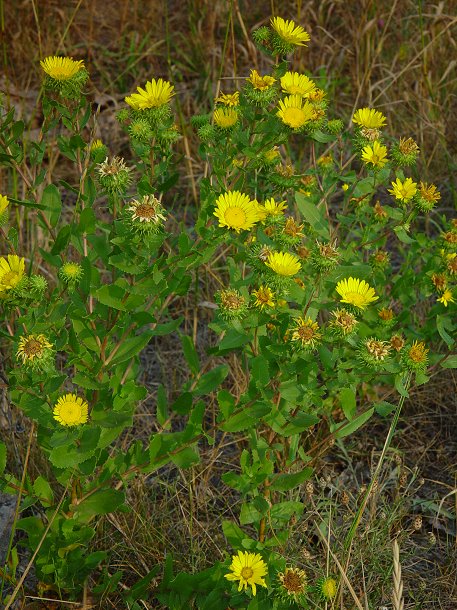Grindelia squarrosa (Pursh) Dunal
Curlytop Gumweed

Native
CC = *
CW = 3
MOC = 13
© DETenaglia
Grindelia squarrosa (Pursh) DunalCurlytop Gumweed | |
 |
Native CC = * CW = 3 MOC = 13 |
© DETenaglia |
|
Family - Asteraceae/Astereae Habit - Biennial forb, rarely short-lived perennial. Stems - To 1 m, erect, glabrous or sparsely hairy near base, usually with ascending branches toward the tip.
Leaves - Stem leaves sessile, to 7 cm, oblanceolate to oblong or ovate, truncate to shallowly cordate at the base and slightly to moderately clasping the stem, mostly bluntly pointeded, the margins with moderate to numerous relatively blunt teeth, these mostly with a thickened or glandular tip, the surfaces appearing strongly resinous with dense glandular dots, these conspicuously darker than the surrounding leaf tissue, otherwise glabrous. Basal leaves similar to lower stem leaves, absent at flowering.
Inflorescence - Solitary heads or loose terminal clusters in branch tips, occasionally a few heads in leaf axils. Involucre - Receptacle 1-2 cm in diameter. Involucre 6-11 mm long, the bracts in 5-9 unequal series, linear, strongly curled or recurved
Ray flowers - Ray florets 20-40 (rarely absent), pistillate, with ligules 7-15 mm long. Disk flowers - Perfect, sometimes functionally staminate at inside or outside of disk, the corollas 3.5-6.5 mm long. Pappus of 2-8 slender awns, 2.5-6.0 mm long, these usually barbed, not persistent at fruiting (usually shed individually as the fruit matures), off-white to straw-colored.
Flowering - July - September. Habitat - Waste ground, roadsides, railroads. Origin - Native to the U.S. Lookalikes - G. lanceolata. Other info. - This easily identifiable species can be found scattered throughout Missouri but is absent from most of the south and central portions of the state. It is very common throughout the western half of the U.S. The plant can be identified by its gummy-sticky heads and recurved bracts. There are currently three varieties recognized in Missouri: var. nuda, which lacks ray florets, var. quasiperennis, which has entire or inconspicuously toothed leaf margins, and var. squarrosa, which conforms to the descriptions above and the most common in this state. The taxononmy of the complex is still not fully understood. Photographs taken in Marquette, MI., 9-5-2003 (DETenaglia); also near Ravenna Lake State Recreation Area, Buffalo County, NE, 8-21-2012, and near Moorcroft, Crook County, WY, 8-22-2012 (SRTurner). |